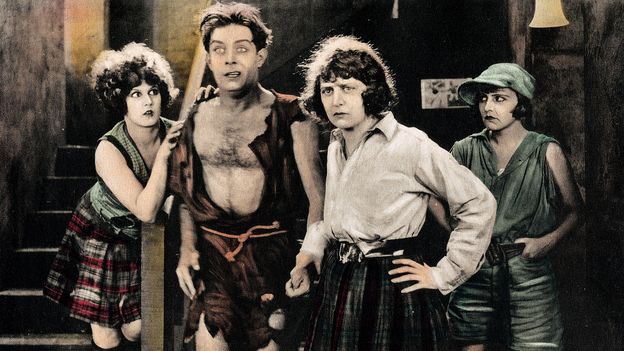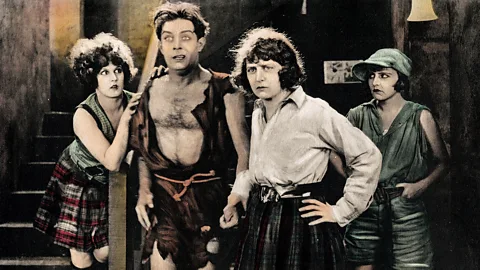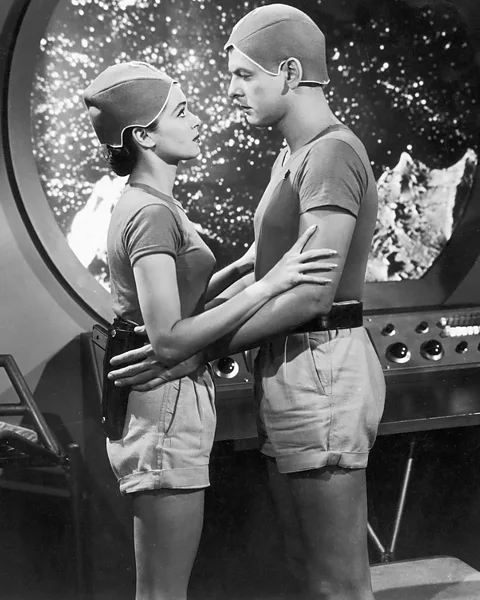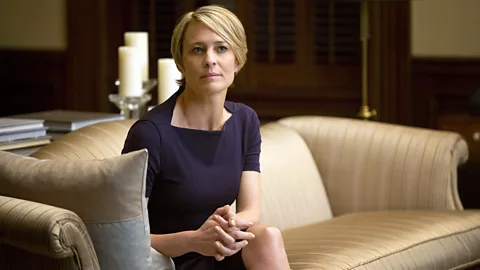Bussiness
In 1924 a risqué silent film featured a woman as US president – what happened on screen in the 100 years that followed?

 Alamy
AlamyThe Last Man on Earth is one of the earliest films in history to feature a female president of the US. It set the tone for the films and shows that came next.
One hundred years ago, a woman was elected as the president of the United States. This didn’t happen in reality, of course, but a fictional female president did appear in a film that was released exactly a century ago, in 1924 – and it’s one of the earliest surviving on-screen examples of a woman in that role.
The Last Man on Earth is a silent comedy starring Earle Foxe and directed by JG Blystone. Foxe plays Elmer, the one adult male in the future year of 1954 who hasn’t been snuffed out by a disease called “masculitis”. Luckily for him, he was living alone in a forest when the virus struck, so when he is brought back to civilisation, he is a sought-after specimen. The government buys him for $10m and two “senatresses” have a boxing match for the right to marry him – but Elmer only has eyes for his childhood sweetheart.
Adapted from a short story by John D Swain, The Last Man on Earth is really an excuse to have some risqué fun with the male fantasy of being pursued by countless women. “Little, if any, attempt is made to conceal the fact that they are impelled by sex impulse,” tutted the Virginia State Board of Censors in its review of this “smutty” and “indecent” work. But the film also mocks the very idea of a society with women in charge. The White House is overgrown and unkempt, while the president herself (Martha Mattox) prefers to tend to stray cats than to run the country.
 Alamy
Alamy“Just imagine,” says Erika Cornelius Smith, director of Research Strategy at the University of Illinois, and an expert on depictions of women in fiction. “Women boxing! Women in government! The only way audiences could cope with this type of thing in popular culture was that they knew it was absurd and it would never happen.”
For the rest of the 20th Century, there weren’t many other female US presidents on screen. Betty Boop and Olive Oyl made brief animated trips to the White House in 1932 and 1948, respectively, but most film-makers stuck to the familiar status quo of male presidents. “Popular culture is a space of creativity and imagination and possibility,” says Smith. “But [film and television creators] struggle to balance this wonderful opportunity to be creative with the need to sell advertising and make a profit. Their shows have to have a market. Possibility and profitability are always going to compete.”
But why would a female president threaten that profitability? If a film or a TV series departs from reality in other regards, why shouldn’t it shake things up in this particular way, too? Karrin Vasby Anderson of Colorado State University is the co-author of a book on the subject, Woman President, and she argues that, in the past, such a character might have put off more conservative viewers. “The US presidency has long been one of the world’s most important displays of traditional masculinity and heteronormative family values, with the first lady playing an important supporting role,” she says. “A woman president upends that.”
Changing tropes
That could be one reason why, when a female president does crop up on screen, she is rarely taken seriously: in many respects, the president in The Last Man on Earth set the tone for her less-than-inspiring successors for decades to come. One recurring element is that the scenario is set in the future when, the implication goes, the world is bizarrely different from our own. The first example of this, after The Last Man on Earth, is Project Moonbase, which was released in 1953 and set in the year 1970. Ernestine Barrier plays madam president, and other women occupy positions of power – although as Smith points out, the heroine (Donna Martell), a colonel in charge of a lunar mission, is “easily frightened and turns to her male colleague and love interest as soon as the situation becomes dangerous”.
 Getty Images
Getty ImagesFemale presidents would go on to be seen in the imagined futures and futuristic alternate realities conjured up by Back to The Future Part II (1989), Battlestar Galactica (2003-2009), Independence Day: Resurgence (2016), For All Mankind (2019-present) and Don’t Look Up (2021). In Bart to the Future, an episode of The Simpsons from 2000, Lisa Simpson grows up to be “America’s first straight female president”. One of the episode’s prescient jokes is that her predecessor was a certain President Trump.
Another trope is that female presidents aren’t often put in the White House by an ordinary, free and fair election, but by a crisis. It’s an especially severe crisis in The Last Man on Earth, of course. To quote Farran Smith Nehme in Film Comment: “For a woman to be elected president, literally every single man on Earth – save one tree-dwelling hermit who presumably wasn’t registered to vote – had to die first.” But even in less extreme scenarios, it’s common in films and shows for a woman to step in only after the male president has died or resigned while in office. Just look at some of the most recent examples: Geena Davis’s Mackenzie Allen in Commander in Chief (2005), Patricia Wettig’s Caroline Reynolds in Prison Break (2005-2017), Julia Louis-Dreyfus’s Selina Meyer in Veep (2012-2019), and Robin Wright’s Claire Hale Underwood in House of Cards (2013-2018) all became presidents without voters’ approval.
 Alamy
AlamySimilarly, the fictional women themselves aren’t always keen to do the job. “In television and film, the only women who can be trusted as US president are those who don’t want to be there,” says Anderson. “Heroic women presidents, like Téa Leoni’s character in Madam Secretary, have to be dragged into public service. Women with political ambition, such as Cherry Jones’s president in 24 and Julia Louis-Dreyfus’s character in Veep, prove to be untrustworthy, or their presidencies often end in tragedy. Fictional male presidents can be principled, effective, and politically ambitious. Women on screen still have to choose between ambition and trustworthiness.”
Another lingering trope is that female presidents on screen seem to have trouble concentrating on governing. The president in The Last Man on Earth is busy with stray cats, but her later equivalents are usually distracted by their husbands and children. Hail to the Chief, an ABC sitcom from 1985, had Patty Duke as Julia Mansfield, a president juggling politics with family. Twenty years on in 2005, the advertisements for ABC’s Commander in Chief billed Davis’s character as “a woman president who has the world on her shoulders and her children on her back”.
Still, 100 years after The Last Man on Earth, the tropes are changing, however slowly. There have already been more fictional female presidents in the 21st Century than there were in the 20th, and there are even cases in which their gender isn’t the main issue. Meryl Streep’s Janie Orlean in Don’t Look Up (2021) may be a terrible president, but that’s not because she’s a woman, while Alfre Woodard’s Constance Payton in State of Affairs (2014-2015) is competent and tough.
 Alamy
AlamyHillary’s Clinton’s presidential bid in 2016 was undoubtedly influential. “Certainly the visibility of candidates like Hillary Clinton made a significant impact on these types of characters,” says Smith. “I don’t think Elizabeth McCord [in Madam Secretary], for instance, is exactly based on Clinton, but there was a level of seriousness to Clinton’s candidacy which lent itself to McCord’s candidacy. And that show really struck me as different from the mould in a lot of ways, both in that it was trying to address the stereotypes in prior depictions, and it was trying to move past them.”
In general, Smith adds, the more women in politics there are in reality, the more there are in fiction – and, potentially, vice versa. “These shows were made when there were very serious candidates running not just for president but for governor and for positions in the Senate and Congress, so having real examples cues writers and those in the industry to start thinking about storylines with those characters. Reciprocally, how they then craft those characters and storylines shapes how we imagine those individuals will act in office, so I see it as a feedback loop.”
It’s worth considering a film that was ahead of its time… most of the way through, anyway. Kisses for My President is a 1964 comedy in which Polly Bergen plays the president, and Fred MacMurray plays her husband, who struggles with being a “male first lady”. “It actually offers a pretty progressive depiction of a woman president,” says Anderson. “She’s a smart and skilled politician voted into office by a united and enthusiastic cohort of women voters.”
The film didn’t carry its progressive premise all the way through, however. After the president faints, she discovers that she is pregnant, so she resigns from office to devote herself to motherhood. “You can’t work and be pregnant – you can’t work and raise a family, that’s absurd,” laughs Smith. “And if the president can’t work and raise a family, that definitely sends a message to the rest of women in society.”










![LeoVegas Casino review 🦁 Up to €1,000 + 200 free spins [2024] LeoVegas Casino review 🦁 Up to €1,000 + 200 free spins [2024]](https://talksport.com/wp-content/uploads/sites/5/2024/11/talksport-leovegas-casino-op.jpg?strip=all&quality=100&w=1920&h=1080&crop=1)